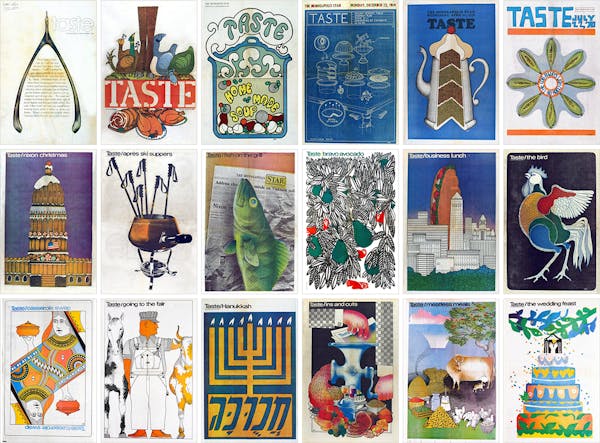Those old photographs of food from the Dark Ages — you know, 50 years ago — look so, well, out of date.
A tabletop filled, corner to corner, with platters of undefinable edibles (at least we think they're edibles)? Curious props on the set?
Yes, just as fashion — and kitchens, cars and haircuts — have trends, so does food styling (what's the mullet and shoulder pads of the food world?).
To get a perspective on the evolution of food in front of the camera, we talked with Carmen Bonilla of Stillwater, who served as Taste's de facto culinary stylist for 32 years.
She was not the usual candidate to pick up a tweezer (to move peas and cereal), cans of propane (to brown crème brûlée) or spritz bottles (to hydrate produce) when she turned to her second career. Back in the '80s, food stylists came from the ranks of home economists.
Not so for Bonilla. After an art degree and two decades in the restaurant industry as a chef, she switched careers, getting her break when a senior food stylist at General Mills took Bonilla under her wing. Locally, many food stylists learned the basics and beyond at the home of Betty Crocker.
Q: What about those old food photos with everything but the kitchen sink in the picture?
A: I call it "giving the client their money's worth." It was a trend for a while, particularly in cookbooks, and especially if the intent was to show something as being family-friendly and there was a desire to make it look like it could feed a lot of people or show off a big spread for entertaining. That was the idea anyway. Sometimes it was simply old-school design where a lot of people didn't like empty space and felt compelled to fill that space. More was more, then, in food photos, and today less is more.
Q: What drove the changes in the way food looks on the plate in photographs?
A: The whole photo industry for food revolved then around control in the studio. It was painstaking work. One photo shoot took hours and hours and hours of work, as opposed to today with digital photography. Back then we took Polaroids and adjusted the food accordingly. Everything had to be in its place. It was very stylized and stiff. As magazines and restaurants changed their approach, food styling had to move along with what they were doing. Generally, the whole style of food is more natural today, more real, with messy plates and sprinkled herbs. Everyone is happier with that. Photography for packaging, however, is still very controlled.
Q: You hear stories of how fake the food can be in photo shoots. Was that ever true? Photos in Taste have always used real food.
A: Back in those days, food stylists turned to a lot of crazy stuff that shouldn't have gone into food. There were a lot of substitutes used, tricks like using shaving cream instead of whipped cream. Another trick for photos, when milk would be poured onto cereal, was to use Elmer's glue for the "milk" because it poured better. That changed after a lawsuit, prompted by Campbell's Soup [in 1968], which used marbles in the bottom of a bowl to raise the ingredients for a photograph. General Mills, however, wouldn't allow us to use anything that wasn't real food. They had very strict guidelines about not using anything inedible. They had rules about portions, too. You could use less than a recipe in a photo, but never more.
Q: Why the simpler focus today?
A: Digital photography is the driving force, and everybody is in a time crunch. In the past we could spend a whole day on one photo no matter how many foods were in it, but that just doesn't happen anymore. You can do editing and turnaround faster. When digital came along, I worried that a lot of pictures would be photoshopped, but that's not the case for photographers and editors, who keep it to a minimum. If it's a product being photographed for advertisements, legally you have to stay within guidelines.
Q: What's difficult to portray in a photo shoot?
A: Ice cream. A fake version is still used occasionally in the industry, though it is made up of food — Karo syrup, powdered sugar and Crisco shortening. You knead it into a dough and use as is for vanilla ice cream or color it for strawberry or chocolate. It's still used as a stand-in because ice cream melts so fast. Then you would set up the lighting, ditch the stand-ins and scoop out real ice cream for the photo shoot.
There are some photographers who build ice huts inside their studios. These little huts have air conditioning blown in. It's like a deep freeze. The stylists are in ski gear as they scoop ice cream, put it on the set and photograph quickly and naturally. It's more fun to do it this way.
Q: What was the worst you had to style?
A: Cat food straight out of a can, on a teeny plate a few inches from my nose. It was for a pet store company.
Q: Any other surprises in the photo studio?
A: I did a bakery spread that took days to make all the food we were shooting. We broke for lunch and the bakery owner had a dog there and said the dog was well trained and wouldn't go after the food. But the dog got into the pastries and ruined the whole shoot.
Q: Ah, yes, the "dog ate my props" excuse!
A: Then there was an art director who grabbed a sandwich to eat that we had just photographed. He didn't see that it had pins in it so it wouldn't fall over during the photo. It was a close call, but someone grabbed the sandwich from him.
